#AIR RAID PEARL HARBOR
Photo

USA 1990
#USA1990#GENERAL QUARTERS SOFTWARE#STRATEGY#SIMULATION#APPLE#IBM#MIDWAY THE BATTLE THAT DOOMED JAPAN#AIR RAID PEARL HARBOR
15 notes
·
View notes
Text
So, imagine you're a teenager from rural Arkansas who grew up working on the family farm equipment. And you grow up in the poverty of the Depression, then as you first come to an age of understanding the world, a war breaks out.
And then that war hits Pearl Harbor.
And you, teenager from rural Arkansas, end up a mechanic because you grew up working on farm equipment, and you're really fucking good at it. And at the age of 19--probably the same age your parents married, frankly--you're in charge of a whole crew of other mechanics for an entire bombing company. And you are considered the absolute best of the best. You're not just respected; you're talked to as an equal. You're teased by men way above your own status but in a friendly and welcoming way.
And you are so goddamn good at what you do that one of the very best pilots in that whole company absolutely believes that you can fix a serious issue while he taxis on the runway and you balance on the landing gear.
And then you do it.
And then that pilot doesn't come back.
*
And imagine you're a guy from Wisconsin with wishes of being a gangster from New York City, so you create yourself a bit of a persona, all charm and swagger and quick smiles. And you go to flight school and meet a guy who looks like your childhood best friend, and when you nickname him the same as that guy, this other guy doesn't stop you. And he doesn't like any of your vices. But he doesn't care that you have them. He doesn't mind being around them. Enjoys watching you act out and enjoys riling you up as well.
And he tells you, "You need a pass to London," and you invite him along, meaning it, but also not surprised when he turns you down. Because he doesn't paint the town red. He has fun in his own way. Like picking up a full-grown Husky and dancing with him to the slow song the band is playing.
And you go to London and drink and fuck and start realizing your own mortality. And then you see how bad the bombing run really was, and you call in and find out that your dearest friend in the world (so dear that no matter how casual you come off, everyone knows how devoted you are to each other), didn't come back.
From a raid you could have been on.
*
And imagine, one last time, you're a navigation genius who makes the best charts in the whole company. And your best friend is damn near as good as you but just needs a little confidence. So fucking good is he, in fact, that he can pick up on the fly when you're sick and take care of those boys you both care about so much.
You give him your good luck charm and tell him to keep it. He never tells you he kisses it or puts it where he can always see it when he's scared.
And your best friend knows you don't actually like the part where you have to be in the bomber, and he gives you a gift: When asked to be the one to stay on the ground (where he wouldn't have to fight air sickness to do his job), he says no. And gets you the job instead.
Because you love each other. You care for each other. You take care of each other.
And then he doesn't come back. On a mission you personally plotted for the whole company. On a mission that might have been yours if you'd stayed in the air.
And his wife says hello to you in all her letters and the way she signs her name makes your best friend smile like nothing has ever gone wrong in the world.
262 notes
·
View notes
Text
An updated (April 3, 2024 7:48am pst) list of WW2 movies and TV shows in chronological order
thought out WW2
-(Imitation Game 2014)
-(The Book Thief 2013)
-(The Zookeeper’s Wife 2017)
-(The Pianist 2002)
1937
October 26, 1937 Defence of Sihang Warehouse (The Eight Hundred 2020)
December 13, 1937 Nanjing Massacre
- (John Rabe 2009)
- (The Flowers of War 2011)
1938
Fall of 1938 (Munich – The Edge of War 2022)
1939
Summer 1939 (Six Minutes to Midnight 2020)
September 3, 1939 King George VI first wartime speech (King’s Speech 2010)
September 17, 1939, Soviet Union Invitation of Poland (The Way Back 2010)
November 30, 1939 Soviet Union invades Finland (The Winter War 1989)
1940
April 9, 1940 Operation Weserübung
-(April 9th [movie] 2015)
-(King’s Choice 2016)
-(Narvik 2022)
-(War Sailors 2023)
April 27, 1940 (Into the White 2011)
June 4, 1940
-Churchill gives “We Shall Fight on the Beaches” speech (Darkest Hour 2017)
-Dunkirk Evaluation (Dunkirk 2017)
July 10-October 31, 1940 Battle of Britain (Battle of Britain 1969)
1941
May 1941 (Call to Spy 2019)
June 22, 1941 Operation Barbarossa
-(Fortress of War [The Brest Fortres 2010)
-(Defiance 2008)
September 8, 1941, Siege of Leningrad begins.
-(Battle of Leningrad [Saving Leningrad] 2019)
-(Leningrad 2009)
October 1941 Battle of Moscow (The Last Frontier [The Final Stand] 2020)
October 1941 Battle of Sevastopol (Battle for Sevastopol 2015)
December 7, 1941, the Empire of Japan attacks Pearl Harbor (Tora! Tora! Tora! 1970)
December 8, 1941 Japan invades Shanghai International Settlement (Empire of the Sun 1987)
1942
January 20, 1942, Wannsee Conference (Conspiracy 2001)
February 1942 Battle of the Atlantic (Greyhound 2020)
February 1942 (The Railway Man 2013)
February 19, 1942, Bombing of Darwin (Australia 2008)
Spring 1942 (U-571 2000)
April 18, 1942 The Doolittle Raid (In Harm’s Way 2018)
June 4, 1942 Battle of Midway (Midway 2019)
1942 Summer Occupation of Jersey Island (Another Mother’s Son 2017 Prime)
July, 10 1942 Easy Company Trains in Camp Tocca (Band of Brothers 01x10 Currahee 2001)
July 21, 1942, Kokoda Track Campaign (Kokoda: 39th Battalion 2006)
August 7, 1942, 1st Marine Division land on Guadalcanal (The Pacific Ep. 1 Guadalcanal/Leckie 2010)
August 19, 1942, Dieppe Raid (Dieppe 1993)
August 23, 1942 Battle of Stalingrad begins (Stalingrad 1993)
September 1942 Formation of Troop 30 (Age of Heroes 2011)
September 18, 1942, 7th Marines Land on Guadalcanal (The Pacific Ep. 2 Basilone 2010)
Autumn of 1942 Battle of the Atlantic (Das Boot 1981)
October 18, 1942, Operation Grouse (Heavy Water War Ep. 2 2015)
November 8, 1942, Operation Torch (The Big Red One 1980)
November 10-17 1942 Vasily Zaytsev kills 225 German Soldiers during the Battle of Stalingrad (Enemy at the Gates 2001)
December 1942 The 1st Marine Division on Guadalcanal is relieved (The Pacific Ep. 3 Melbourne 2010)
December 15, 1942, Battle of Mount Austen (Thin Red Line 1998)
1943
March 13-14 1943, liquidation of the Kraków Ghetto -(Schindler’s List 1993)
April 17, 1943 Operation Mincemeat (Operation Mincemeat 2021)
April 19, 1943, beginning of the Warsaw Uprising (Uprising 2001)
May 4, 1943, Final Mission of The Memphis Bell (Memphis Bell 1990)
May 15, 1943, Salamo Arouch and his family arrive in Auschwitz Concentration Camp (Triumph of the Spirit 1989)
May 27, 1943 Louis Zamperini plane crashes on a search and rescue mission (Unbroken 2014)
May 30, 1943 first All-American Girls Professional Baseball League game played (A League of Their Own 1992)
June 25, 1943, 100th Bomb Group flew its first 8th Air Force combat mission (Master of the Air: Part One 2024)
July 1943
-(The Tuskegee Airmen 1995)
-(The Liberator Ep. 1 2020)
-(Heavy Water War Ep. 5 2015)
July 16, 1943, The 100th Bomb Group bombed U-Boats in Tronbhdim (Masters of the Air: Part Two 2024)
August 17, 1943 the 4th Bomb Wing of the 100th Bomb Group bombed Regenberg (Masters of the Air: Part Three 2024)
September 16, 1943, William Quinn and Charles Bailey leave Belgium (Masters of the Air: Part Four 2024)
September 18, 1943 John ‘Bucky’ Egan returns from leave to join the mission to bomb Munster (Master of the Air: Part Five 2024
October 14, 1943, John ‘Bucky’ Egan interrogated at Dulag Lut, Frankfurt Germany (Masters of the Air: Part Six 2024)
December 26, 1943, 1st Marine Division lands on Cape Gloucester (The Pacific Ep. 4 Gloucester/Pavuvu/Banika 2010)
1944
January 22, 1944, Battle of Anzio
-(The Liberator Ep. 2 2020)
-(Red Tails 2012)
-(Anzio 1968)
February 20, 1944, Hydro Ferry bombing (Heavy Water War Ep. 6 2015)
March 7, 1944, Stalag Luft III Sagan, Germany, Germans find the concealed radio Bucky was using to learn news of the War (Master of the Air: Part Seven 2024)
March 24/25, 1944 Allied Mass Escape of Stalag Luft III (The Great Escape 1963)
June 1944 (Cross of Iron 1977)
June 6, 1944, 00:48 & 01:40 First airborne troops begin to land on Normandy (Band of Brothers 02x10 Day of Days 2001)
June 6, 1944, 06:30 D-Day landings
-(Storming Juno 2010)
-(Saving Private Ryan 1998)
June 10, 1944, Easy Company Takes Carentan (Band of Brothers 03x10 Carentan 2001)
June 15-July 9, 1944 Battle of Saipan
-(Windtalkers 2002)
-(Oba: The Last Samurai 2011)
July, 1944 The Monuments Men land in Normandy (The Monuments Men 2014)
July 20, 1944 Operation Valkyrie (Valkyrie 2008)
August 12, 1944, The 332nd Fighter Group attack Radar stations in Southern France (Masters of the Air: Part Eight 2024)
September 15, 1944, U.S. Marines landed on Peleliu at 08:32 (the Pacific Ep. 5 2010)
September 16, 1944, U.S Marines take Peleliu Airfield (the Pacific Ep. 5 2010)
September 17, 1944, Operation Market Garden
-(Band of Brothers 04x10 Replacements 2001)
-(A Bridge Too Far 1977)
October 2, 1944 Battle of Scheldt (Forgotten Battle 2021)
October 12, 1944, Battle of Peleliu, Assault on Bloody Nose Ridge (the Pacific Ep. 7 Peleliu Hills 2010)
October 13, 1944, Rovaniemi public buildings were destroyed (Sisu 2022)
October 14, 1944, Erwin Rommel is arrested (Rommel 2012 Prime)
October 22/23, 1944, 2100 – 0200 Operation Pegasus (Band of Brothers 05x10 Crossroads 2001)
November 1944 middle of the Battle of Hürtgen Forest (When Trumpets Fade 1998)
December 16, 1944, Battle of the Bulge (Band of Brothers 06x10 Bastogne 2001)
December 1944 (Hart’s War 2002)
1945
January 2, 1945 (The Liberator Ep 3 2020)
January 10, 1945 (Attack Force Z)
January 13, 1945, Battle of Foy (Band of Brothers 07x10 The Breaking Point 2001)
January 30, 1945 The Raid at Cabanatuan (The Great Raid 2002)
February 14, 1945, David Webb rejoins the 506th in Haguenau (Band of Brothers 08x10 The Last Patrol 2001)
February 19, 1945, Battle of Iwo Jima starts.
- (Letters from Iwo Jima 2006)
- (The Pacific Ep. 8 Iwo Jima 2010)
- (Flags of our Fathers 2006)
March 21, 1945, Operation Carthage (The Bombardment 2021)
April, 1945 (Fury 2014)
April 5, 1945, 506th Finds abandoned Concentration Camp
(Band of Brothers 09x10 Why We Fight 2001)
April 26, 1945, near the end of the war in Europe (A Woman in Berlin 2008)
April 29, 1945, 45th Infantry Division liberated Dachau Concentration camp (The Liberator Ep. 4 2020)
May 2, 1945, Fall of Berlin
-(Downfall 2004)
-(Jojo Rabbit 2019)
May 1945 Battle of Okinawa
-(Hacksaw Ridge 2016)
-(The Pacific Ep. 9 Okinawa 2010)
May 7, 1945, Germany Surrenders V-E Day
- (Master of the Air: Part Nine 2024)
- (Band of Brothers 10x10 Points 2001)
July 30, 1945, USS Indianapolis sank.
(USS Indianapolis 2016)
August 15, 1945, The Empire of Japan surrenders end of the War.
-(Oppenheimer 2023)
-(The Pacific Part Ten: Home 2010)
September 11, 1945 US Military search and Arrest Japanese Leaders for war crimes (Emperor 2012)
1946
April 29, 1946 Tokyo War Crimes Tribunal (Tokyo Trial 2016)
63 notes
·
View notes
Text
100th Bomber Boys: Major Robert 'Rosie' Rosenthal: Pt. 1
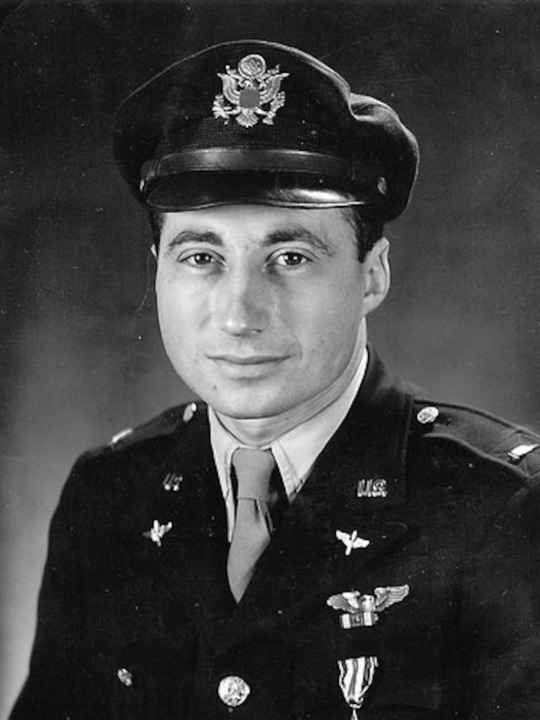
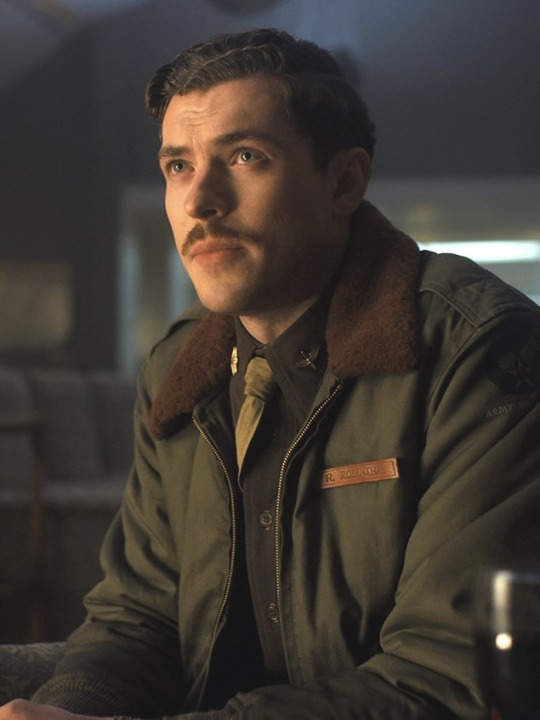

Ahead of the show's release, I bought Donald Miller's book and am reading it! Here is a little bit about Major Robert 'Rosie' Rosenthal (played by Nate Mann) from the prologue of Masters of the Air (pg. 13-14)!
Lt. Robert "Rosie" Rosenthal had not trained with the Hundredth's original crews. He and his crew had been assigned to the group that August from a replacement pool in England, to fill in for men lost on the Regens-burg raid. "When I arrived, the group was not well organized," Rosenthal recalled. "They were a rowdy outfit, filled with characters. Chick Harding was a wonderful guy, but he didn't enforce tight discipline on the ground orin the air."
Rosenthal didn't fly a mission for thirty days. "No one came around to check me out and approve me for combat duty. Finally, my squadron commander, John Egan, had me fly a practice formation. I flew to the right of his plane. I had done a lot of formation flying in training and I was frustrated; I desperately wanted to get into the war. I put the wing of my plane right up against Egan's, and wherever he went, I went. When we landed, Egan told me he wanted me to be his wing man."
Rosenthal had gone to Brooklyn College, not far from his Flatbush home. An outstanding athlete, he had been captain of the football and baseball teams, and later was inducted into the college's athletic hall of fame. After graduating summa cum laude from Brooklyn Law School, he went to work for a leading Manhattan law firm. He was just getting started in his new job when the Japanese bombed Pearl Harbor. The next morning he joined the Army Air Corps.
He was twenty-six years old, with broad shoulders, sharply cut features, and dark curly hair. A big-city boy who loved hot jazz, he walked, incongruously, with the shambling gait of a farmer, his toes turned inward and there wasn't an ounce of New York cynicism in him. He was shy and easily embarrassed, but he burned with determination. "I had read Mein Kampf in college and had seen the newsreels of the big Nazi rallies in Nuremberg, with Hitler riding in an open car and the crowds cheering wildly. It was the faces in the crowd that struck me, the looks of adoration. It wasn't just Hitler. The entire nation had gone mad; it had to be stopped.
"I'm a Jew, but it wasn't just that. Hitler was a menace to decent people everywhere. I was also tremendously proud of the English. They stood alone against the Nazis during the Battle of Britain and the Blitz. I read the papers avidly for war news and listened to Edward R. Murrow's live radio broadcasts of the bombing of London. I couldn't wait to get over there.
"When I finally arrived, I thought I was at the center of the world, the place where the democracies were gathering to defeat the Nazis. I was right where I wanted to be."
Rosie Rosenthal didn't share these thoughts with his crewmates, simple guys who distrusted what they called deep thinking. They never learned what was inside him, what made him fly and fight with blazing resolve.
Later in the war, when he became one of the most decorated and famous fliers in the Eighth, word spread around Thorpe Abbotts that his family was in a German concentration camp. But when someone asked him directly, he said "that was a lot of hooey." His family-mother, sister, brother-in-law, and niece (his father had recently died) were all back in Brooklyn.
"I have no personal reasons. Everything I've done or hope to do is strictly because I hate persecution... A human being has to look out for other human beings or else there's no civilization."
Rosie was part of the 'Bloody 100th' Bombardment Group of the 13th Combat Wing, of the 'Mighty Eighth' Air Force with John 'Bucky' Egan and Gale 'Buck' Cleven (played by Callum Turner and Austin Butler) His plane was called Rosie's Riveters, and him and his crew were an integral part of the bombardment group.
On October 8th, 1943, the 100th went on a bombing run to Bremen, Germany, and Buck Cleven was shot down. Two days later, Egan and the rest of the 100th went on a supposedly "easy" mission to Münster, accompanied by P-47 Thunderbolts almost all the way to the target. Rosenthal and his crew were not flying their beloved Rosie's Riveters due to damage from their two previous missions in Bremen and Marienburg. Instead, they flew Royal Flush.
Rosie's crew was worried about flying a brand new plane, and became incredibly nervous. Bringing them together under one of the wings, he calmed the boys down and lifted their spirits. This mission proved disastrous, and Royal Flush was the only one in the 100th to make it back to Thorpe Abbotts (the 100th's air-base in East Anglia).

Needless to say, I love Rosie already!! I've read up to chapter 6, and I feel like my brain is going to explode with all the information I've taken in :3
lmk if y'all want more posts like this one or would like to be tagged in them!!
#thank you for coming to my TED Talk#this is for everyone who doesn't have access to the book but wants more info on the guys!!!#can you tell i'm a history major??#masters of the air book excerpts#hbo war#bloody hundredth#100 bombardment group#major john egan#donald miller#major robert rosie rosenthal#masters of the air#major gale cleven
47 notes
·
View notes
Text
Some promotional images from Cats at the CPAC Musical Theatre.







Production description undercut (x)
Cats is based on T.S.Eliots 1939 poetry Old Possum's Book of Practical Cats, the songs in the musical consists of Eliot's verse set to music by Andrew Lloyd Webber.
On September 3, 1939, Australian Prime Minister Robert Menzies announced that the country was at war with Germany, a sombre moment for a nation still reeling from the losses of World War I. Despite this, the war still felt remote to those on the home front – that is, until December 1941, when the Japanese bombed Pearl Harbor and began advancing through Southeast Asia. Suddenly, the threat of invasion placed Australia directly in the line of fire, as was evidenced by the bombing of Darwin on February 19. Enter Melbourne, where only a quarter of street lamps were lit and even electric trains had reduced lighting. The city's "brown out" period was a response to the danger of air raids, and it had a profound impact on daily life. In this production, amidst this tumultuous time, one unique story stands out – the inhabitants of Melbourne’s Jellicle Cats and the threat of war upon them. This assemblage of cats must decide who will journey to the ‘heavyside layer’ in a process of selection for each nominated cat to be considered to be reborn into a new life. In this newly reimagined production, our "Cats" tell this tale, set against the backdrop of wartime Melbourne in 1942, with a nod to the social changes brought on by the war effort, post-war reconstruction, migration, and the reintegration of returned servicemen into the local economy. The musical features no dialogue, only music, and provides a unique perspective on a pivotal moment in Australian history.
#cats the musical#cats non replica#cats cpac#I don’t know what the relationship between this production and kilworth is so I won’t say anything about it but yea:3#Very exciting news regardless
27 notes
·
View notes
Text
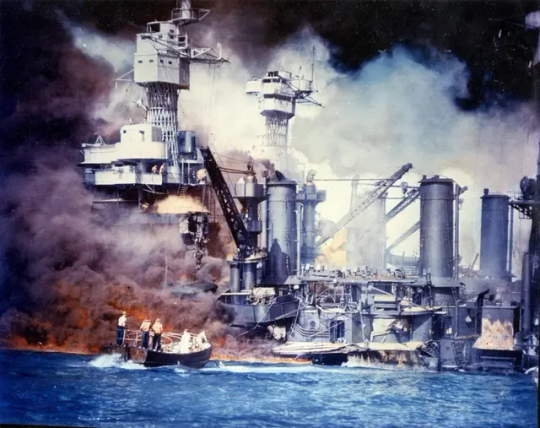
Sailors in a motor launch rescued a survivor from the water alongside the sunken West Virginia during or shortly after the Japanese air raid on Pearl Harbor, 7 Dec 1941.
13 notes
·
View notes
Text

The Philippine Army Air Corps' Baptism of Fire
December 10, 1941
The Philippines was at war. The US Naval base at Pearl Harbor was bombed by the Japanese Navy, while US Air Corps installations in the Philippines were bombed by Japanese aircraft from Formosa. These two attacks resulted in heavy loses on American ships and aircraft. With the destruction of most of the aircraft of the United States States Armed Forces - Far East (USAFEE), both the US and Philippine forces had to rely on the remaining US Air Corps aircraft, as well as the Philippine Army Air Corps' 6th Pursuit Squadron.
Under the command of Captain Jesus Villamor, the 6th Pursuit Squadron was deployed at Zablan airfield, ready to take to the air in an event of a Japanese air raid. On December 10, 1941, the pilots of the squadron heard the sound of distant church bells, thus alerting them to an impending air attack. Rushing to their outdated P-26 fighter aircraft, they began taking off just as Japanese Zero fighters started to strafe their airfield.
In the battle the followed, four P-26s fought against the more advance Japanese Zero fighters. Despite the disadvantage towards the Filipinos, the squadron managed to evade the Japanese fighters by hiding in the clouds. Because of this no Filipino aircraft was lost that day. The same could not be said for the Japanese, as they lost two fighters that day, with one kill going to Villamor and a probable kill going to Lieutenant Juliano.
Over the next few days, the Filipino fighter pilots in their P-26s would engage the Japanese in hit and run attacks. In the end the 6th Pursuit Squadron shot down three enemy planes, while losing two of their own in air battles.
By December 24, due to the rapid advance of Japanese ground forces, the Philippine Army Air Corps was forced to abandon their planes, while their personnel retreated to Bataan and Corregidor to help in the defenses there. Because of that the pilots and mechanics were forced to destroy their aircraft.
The Filipino pilots of the 6th Pursuit Squadron fought bravely, despite being outgunned. Their exploits are the legendary and are still remembered today. During the late 40s, as the Philippine Air Force was reorganizing, the 1st Fighter Squadron was redesignated as the 6th Fighter Squadron in honor of the legendary unit that fought in the early days of World War 2.
----------------------------------------
Featuring:
Rooster and @ask-jetstream as pilots of the 6th Pursuit Squadron rushing towards their aircraft during a scramble.
#Art#Random Art#Rooster#JetStream#MLP#My Little Pony#MLP Art#My Little Pony Art#Pegasus#Pegasi#ask-jetstream#Digital Art#History#Philippien History#WW2#World War 2#Philippine Army Air Corps#6th Pursuit Squadron
18 notes
·
View notes
Text

AUTHOR (RE)INTRODUCTION: @WRITINGBYRICOCHET
Having been on Writeblr for ten months and with a recent uptick of followers, I thought it was due for a refresh of my intro! Fingers crossed this one will be a bit more informative about what kind of a writer I am than my first one!
— THE AUTHOR; ♡ —
Megan, Meg, or Lucky (she/her)
20s, Taiwanese American, Eastern Time Zone
Interacts from @luckyricochet
Ask/tag game friendly
In love with history, art, and romance itself
— WRITING; ♡ —
Primarily romance, historical fiction (or historically-inspired), fantasy, fanfiction
Aspirational: Dark academia, gothic
Favorite tropes: friends to lovers, hurt/comfort, sunshine/grump pairings, mutual pining
I love prose that is moody, atmospheric, and deeply emotive in its examination of the human condition almost to the point of romanticism. Besides the universal aims of a solid plot and characters, these are the qualities I want my own work to reflect the most.
— WORKS IN PROGRESS; ♡ —
Between Heaven and Earth
low fantasy/adventure; intro post, tag, wip page
Raised as a princess and heir apparent to the Velitovan throne, Laeisa Durecane's world is suddenly turned upside down when a diplomatic mission turns deadly and her father the King and his entire delegation are killed, leaving Laesia the sole survivor. Having to now abandon peace talks that would have formalized independence for her country, Laesia is forced into exile and takes refuge in the home of a young farmer. The distant rural district she now finds herself in is a far cry from the life of privilege she once enjoyed, but she at least has plenty of time to plot exactly how she will reclaim her throne and finally liberate Velitova.
Tomorrow is a Place
low fantasy/romance; intro post, tag
Do you believe in love at first sight? It’s fine if you don’t—that’s not how it happens in this story, at least not entirely. Even though Merity first takes a shine to the boy next door in childhood, it might have stayed an unspoken crush forever if not for a fateful decision that leaves Fendley wracked by his conscious and Merity his sole confidant. 𝔄𝔪𝔬𝔯 𝔳𝔦𝔫𝔠𝔦𝔱 𝔬𝔪𝔫𝔦𝔞.
(Companion work to Between Heaven and Earth)
Poco a Poco
contemporary romance; intro post, tag
Welcome to Fujiwara Academy of Music, the most prestigious music conservatory in Japan. Balancing academics, work, and an attempt to win a lucrative scholarship is hard enough, but when Rika and Masahiro end up as duet partners, Rika has one more challenge to deal with: Breaking through to the academy’s best musician. It’s just as well that she keep trying, though. After all, chamber music is considered intimate for a reason.
Where Paradise Died and Lived
historical romance/the pacific au fanfic, intro post, tag
The attack on Pearl Harbor takes place far from most Americans’ homes, but for Sophie Holland, it’s right in her backyard. The idyllic tropical isle she knows is now a war zone, where death, suspicion, and martial law are a fact of daily life. With all of America mobilized for the war effort, Sophie joins the Women’s Air Raid Defense to do her part. The job is a welcome diversion that mostly keeps her from her own self-destructive habits, but it’s 1943 now, and her demons only become harder to ignore when the heroes of Guadalcanal—including one new 1st Lieutenant—arrive in Honolulu for rest and recovery.
Other WIPs that I have not formally introduced but am working on in some capacity are here and here. Please send me an ask if you would like to be added to any tag lists!
— CODA; ♡ —
If you've made it this far, thank you for reading! I would love to make new friends and connect with writers who have similar interests, so if any of the above is your cup of tea, please interact and I'll check out your blog! Farewell for now~
#writeblr#wip intro#writeblr community#writers on tumblr#writers of tumblr#wtwcommunity#amwriting#creative writing#writeblr intro#writing
106 notes
·
View notes
Text

#onthisday in 1941 the B-17E Flying Fortress flew for the first time. This featured an increase in armament over previous variants.
@classicwarbirds via X
Boeing B-17 Flying Fortress | Classic Warbirds
Responding to the specification released by the United States Army in May 1934 calling for a multi-engined bomber that was able to carry a bomb load of 2,000lb between 1,020 and 2,200 miles, at a speed of 200 - 250 mph, with a deadline of August 1935 for a prototype of the aircraft to be ready for testing. Boeing submitted their Model 299, which would be powered by four engines. Design of the aircraft began midway through June 1934, and just over a year later, on the 16th July 1935 at Boeing Field, the aircraft was introduced to the press, with the headlines the next day proclaiming a '15-ton Flying Fortress' leading to Boeing registering it as the Model 299 name.
Twelve days later on the 28th July 1935 the B-17 made its first flight, before being flown to Wright Field for testing and evaluation a few weeks later. By making this flight the B-17 met two objectives of the United States Army specification, firstly the journey was 2,100 miles long and was done at an average speed of 252 mph. The prototype comprised armament of five machine guns and could carry more than double the required bomb load of 2,000lb with a 4,800lb maximum load and was powered by four 750-hp Pratt & Whitney R-1690 radial engines. However during testing a setback occurred on the 30th October 1935, when the prototype crashed on take-off, an investigation was to later conclude that the controls had been locked when take-off was attempted. Despite this setback the United States Army Air Corps ordered thirteen YB-17s, later to be called Y1B-17s, as a result of the successful testing before the accident.
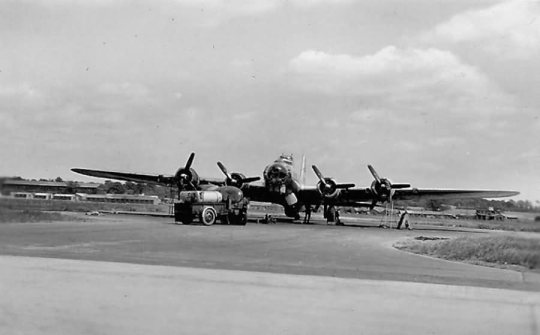
The 2nd December 1936 saw the first Y1B-17 fly, with a few improvements compared to the prototype, the aircraft would now be powered by 930-hp Wright GR-1820-39 Cyclone radials and could accommodate nine crew members. The USAAC's 2nd Bombardment Group based at Langley Field received twelve aircraft during the first eight months of 1937. The other Y1B-17 of the thirteen originally ordered was sent for further testing at Wright Field. A fourteenth example had also been built for testing the strength of the airframe but was later fitted with 1,000-hp engines with turbochargers. After initial problems, it finally flew on the 29th April 1938, with an improvement on its maximum altitude and speed. As this new version was the first variant to enter operational service it was designated the B-17A. Following shortly after was the B-17B, which, whilst almost identical to the B-17A, featured a larger rudder. This first flew on the 27th June 1939 and just over a year later, on the 21st July 1940, the new B-17C flew with 1,200-hp engines.
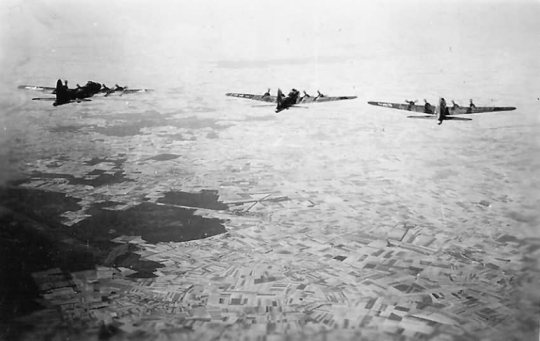
It was with the Royal Air Force that the B-17 was to first experience combat during the Second World War (1939 - 1945) when No. 90 Squadron, which reformed on the 7th May 1941 at RAF Watton, received the B-17C, designated Fortress I that same month. On the 8th July 1941 they took part in their first RAF raid against the naval barracks at Wilhelmshaven, Germany, however, bombing from 30,000 ft they failed to hit the target. Over the next two months another 26 attacks were made on various German targets, and with eight Fortress Is lost due to combat or accidents the Fortress I proved unsatisfactory for use by Bomber Command for daylight bombing. The remaining Fortress Is were transferred to Coastal Command. As a result of the poor performance of the B-17 over Europe a number of areas where the aircraft could be improved were found, these included more defensive armament to combat attacks from German fighters and a higher service celling. By the end of 1941, the United States was drawn into the Second World War after the Japanese attack on Pearl Harbor on the 7th December 1941.

The introduction of the B-17D, with additional armour and self-sealing tanks, and the B-17E, which flew for the first time on the 5th September 1941. The United States Army Air Force first raid over Europe was on the 17th August 1942, when twelve B-17Es escorted by Supermarine Spitfires of the Royal Air Force attacked the marshalling yards at Rouen in France, only two aircraft sustained minor damage and the mission was a success.

Flying for the first time on the 30th May 1942, the B-17F featured a redesigned nose, more armour and increased fuel capacity. Along with the B-17E it would be the Flying Fortress versions most extensively used by the Eighth Air Force. However mounting losses during the daylight raids were to show that the Flying Fortress either on its own or flying in formation could not defend themselves. Although the B-17G appeared with a gun turret in the nose section to limit the aircraft's vulnerability to head on attacks, daylight raids deep into Germany saw heavy losses. The introduction of the North American P-51 Mustang and Republic P-47 Thunderbolt equipped with external fuel tanks saw losses reduced.
The Boeing B-17 Flying Fortress was used wherever US forces were. In the Pacific theatre of war they were used for close-support bombing, patrol and reconnaissance. A few B-17's were produced for special operations and purposes and despite production totalling 12,731, only a few hundred would stay in service at the conclusion of the Second World War.
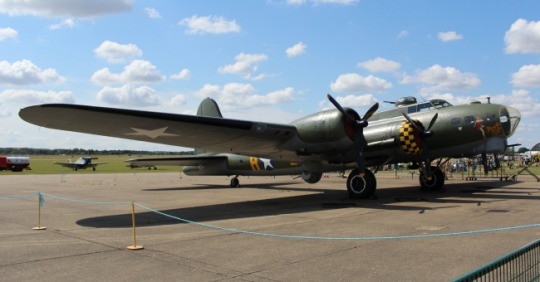
Technical Details
Click on the aircraft image to view a larger version.
Top Speed Range Service Ceiling Armament
B-17A 295 mph 3,600 miles 38,000 ft five 0.30-in machine-guns
eight 600lb bombs
B-17B 292 mph 3,600 miles 36,000 ft six 0.50-in machine-guns
one 0.30-in machine-gun
four 1,100lb bombs
B-17C 323 mph 3,400 miles 37,000 ft five 0.50-in machine-guns
one 0.30-in machine-gun
4,800lb bombs
B-17D 323 mph 3,400 miles 37,000 ft five 0.50-in machine-guns
one 0.30-in machine-gun
4,800lb bombs
B-17E 317 mph 3,200 miles 36,000 ft eight 0.50-in machine-guns
one 0.30-in machine-gun
4,200lb bombs
B-17E side profile image
B-17F 325 mph 2,800 miles 37,500 ft eleven 0.50-in machine-guns
8,000lb bombs
B-17G 302 mph 3,400 miles 35,600 ft twelve 0.50-in machine-guns
8,000lb bombs
B-17G side profile image
XB-38 Sole B-17E tested with a Allison V-1710V engine.
YB-40 292 mph 2,260 miles 29,200 ft at least fourteen 0.50-in machine-guns
C-108 Four aircraft converted and used as cargo carriers and V.I.P transport.
F-9 Designation for a number of B-17s converted into photo reconnaissance aircraft.
BQ-7 Aphrodite B-17s converted into drones.
PB-1 Designation given to B-17s used by the United States Navy.
13 notes
·
View notes
Text
𝐏𝐄𝐀𝐑𝐋 𝐇𝐀𝐑𝐁𝐎𝐑 (𝟐𝟎𝟎𝟏) 𝐒𝐄𝐍𝐓𝐄𝐍𝐂𝐄 𝐒𝐓𝐀𝐑𝐓𝐄𝐑𝐒
TW: BLOOD, WAR, SWEARING, PREGNANCY MENTION, DEATH MENTION
Change pronouns/titles as needed!
"The mission I am asking you to volunteer for is exceptionally dangerous. Take a look at the man beside you. It's a good bet that in the next six weeks, you, or he, will be dead. Everyone brave enough to accept this...step forward."
"Your grandma could take a B-25 off a mile-long runway. Well, I'm gonna train you to do it at 467 feet, because at 468 feet, you're dead, and once you get it up, you're gonna learn to fly it like a fighter. Thirty feet off the ground. I want you to say hello to Lt _________, Navy Aviation. He's gonna help us lighten these fat ladies here."
"Yesterday, December 7th, 1941, a date which will live in infamy, the United States of America was suddenly and deliberately attacked by naval and air forces of the empire of Japan. It is obvious that planning the attack began many weeks ago. During the intervening time, the Japanese government has deliberately sought to deceive the United States by false statements and expressions of hope for continued peace. The attack yesterday on the Hawaiian islands has caused severe damage to American military forces. I regret to tell you that over 3,000 American lives have been lost. No matter how long it may take us to overcome this premeditated invasion, the American people in their righteous might will win through to absolute victory. Because of this unprovoked dastardly attack by Japan, I ask that Congress declare a state of war."
"When the action is over and we look back, we understand both more and less. This much is certain. Before the Doolittle raid, America knew nothing but defeat. After it, nothing but victory. Japan realized, for the first time, that they could lose and began to pull back. America realized that she would win and surged forward. It was a war that changed America. Dorie Miller was the first black American to be awarded the Navy Cross, but he would not be the last. He joined a brotherhood of heroes."
"Slow down, flyboy. And instead of the bottom, read the very top. Both eyes."
"World War II, for us, began at Pearl Harbor, and 1,177 men still lie entombed in the battleship Arizona. America suffered, but America grew stronger. It was not inevitable. The times tried our souls...and through the trial, we overcame."
"I'm sorry, Lieutenant. I really am, but Army and Navy requires 20/20 vision."
"From Berlin, Rome, and Tokyo, we have been described as a nation of weaklings and playboys who hire British or Russian or Chinese soldiers to do our fighting for us. Let them repeat that now. Let them tell that to General MacArthur and his men. Let them tell that to the soldiers who today are fighting hard in the far waters of the Pacific. Let them tell that to the boys in the Flying Fortresses. Let them tell that to the Marines."
"Oh, I... It's not a problem with my eyes. I mean, I can see. I mean, I can hit a runnin' rabbit with a three-dollar pistol. I got a problem with letters, that's all."
"You are so beautiful, it hurts."
"________, you can't die. You can't die. You know why? Because you're going to be a father. You're going to be a daddy. I wasn't supposed to tell you. You're going to be a father."
"_______, I'm pregnant... I didn't even know until the day you turned up alive... and then all this happened... I haven't told _______... I don't want him to know. All he needs to think about is how to do this mission and get back alive."
"Most nurses would've gone on to somebody else instead of keeping their fingers plugged in your artery."
"Oh ______, all I ever wanted was for us to have a home and grow old together, but life never asked me what I wanted. Now I'm going to give _______ my whole heart... but I don't think I'll ever look at another sunset without thinking of you... I'll love you my whole life."
"You know, the only thing that scares me is that you might love him more than you love me."
"If I had one more night to live... I'd wanna spend it with you."
"I joined the army to do MY patriotic duty... AND... to meet guys."
"You're acting like I didn't love you."
"I almost did die, you little son-of-a-bitch. And her face was the last thing that went through my mind."
"I should've died over there. When I was in that water, I made a deal with God. I told him I was sorry, I told him I knew I'd been a fool for leavin you and tryin to go over there and be a hero, and I promised I'd never ask for anything again, if I could just see you one more time... And ya know what? It was worth it. You kept me alive _______, you brought me home. So I'm gonna stand by my end of the deal, I'm gonna walk away, and I won't ask you for anything... but I just want to know why... Just tell me that, will you please? Just tell me why."
"He told me you were a great flyer... The same night he told me, he volunteered to go to England."
"________, loving you kept me alive."
"He volunteered? He-he told me he'd been assigned. He was always tryin' to protect me. But ya know what? I look at myself in the mirror in this uniform... and I still don't know who I am, I look like a hero... but I don't feel like it."
"That's what I want to come home to. That's what I want to have to think about and dream about. I wanna know that the best part of my life is still ahead of me."
#rp meme#sentence starter meme#sentence meme#sentence rp meme#ww2 rp#wwii rp#history rp#ww2 rp meme#pearl harbor 2001 rp#pearl harbor 2001 rp meme
11 notes
·
View notes
Photo
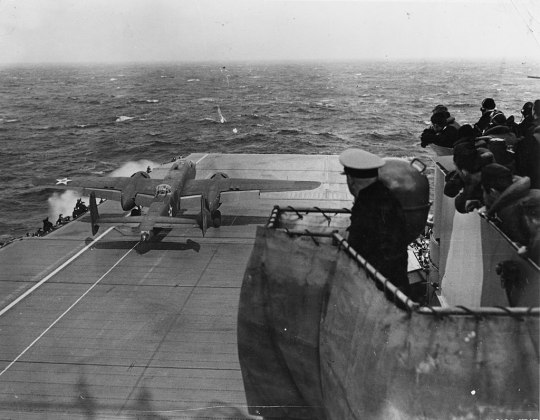
April 18, 1942
The Doolittle Raid, also known as Doolittle's Raid, as well as the Tokyo Raid, was an air raid on 18 April 1942 by the United States on the Japanese capital Tokyo and other places on Honshu during World War II. It was the first American air operation to strike the Japanese archipelago. Although the raid caused comparatively minor damage, it demonstrated that the Japanese mainland was vulnerable to American air attacks. It served as an initial retaliation for the 7 December 1941 attack on Pearl Harbor, and provided an important boost to American morale. The raid was planned by, led by, and named after Lieutenant Colonel James Doolittle.
Apr 10, 2019
Richard “Dick” Cole didn’t just have a front-row seat to history. On an April day in 1942 – just four months after Pearl Harbor – he sat next to Jimmy Doolittle as 16 B-25 Mitchell bombers lumbered down the deck of an aircraft carrier to begin a mission that ended in a huge morale boost for the United States.
Eighty gallant men volunteered for that successful mission – which turned out to be a one-way attack – vengeance for Japan’s strike on Hawaii that crippled the US Navy fleet and left 2,403 dead.
Cole, the last surviving Doolittle Raider, died Tuesday in San Antonio, the US Air Force announced. He was 103.
9 notes
·
View notes
Photo
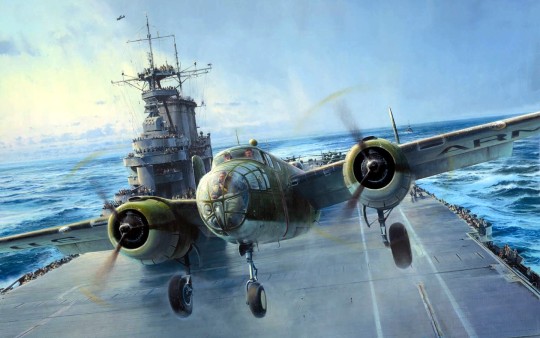
1942 04 18 Into the Teeth of the Wind - Robert Taylor
Bound for Tokyo, Lieutenant Colonel Jimmy Doolittle launches his B-25 Mitchell from the heaving deck of the carrier USS Hornet on the morning of 18 April, 1942. Leading a sixteen-bomber force on their long distance one - way mission, the Doolittle Raiders completed the first strike at the heart of Imperial Japan since the infamous attack on Pearl Harbor four months earlier. Together, they completed one of the most audacious air raids in aviation history.
34 notes
·
View notes
Text
You know who sucks? Douglas MacArthur. And we don't talk about it enough. Let me enlighten you:
Of course my first point is the Bonus Army. MacArthur flat out ignored Hoover's orders to stop the assault and instead launched a new attack because this Bonus March was an "attempt to overthrow the government." 55 veterans were injured, a veteran's wife miscarried, and a 12-week old died from the tear gas. But wait it gets worse...
The veterans had gone back across the Anacostia River where they had set up one of their camps. Hoover ordered MacArthur TWICE (not once, twice) to not cross the river. What do you think he did? He ordered his men to cross the river and evict the veterans and then their shacks were set on fire.
The aftermath? Quoting a Wikipedia article: "Though the Bonus Army incident did not derail the careers of the military officers involved, it proved politically disastrous for Hoover..."
So there were no consequences for MacArthur but it definitely contributed to Hoover not getting reelected.
Let's move on to ww2, where MacArthur NEVER SHOULD HAVE LOST THE PHILLIPINES IN THE FIRST PLACE
So we all know what happened at Pearl Harbor, right? What about Clark Field? You probably haven't heard of that one. Let's dive in:
We are in the Phillipines on December 8, 1941. Pearl Harbor has already happened and MacArthur has been informed. Major General Lewis H. Brereton has asked permission to launch a raid on Formosa. MacArthur wouldn't see him and General Sutherland wasn't any help either. Brereton kept pushing the issue and MacArthur wouldn't let him go through with it (and later on MacArthur would deny ever seeing Brereton that morning, figures). Brereton finally got approval for a reconnaissance mission, nothing more. Later he finally gets approval for an air strike. The planes have to come back and refuel and load their bombs but it is way too late at this point, the Japanese have arrived, and all hell breaks lose. You can imagine that planes full of fuel and bombs make for quite the show. But wait there's more...
The Japanese who launched the attack on Clark Field were delayed a while due to weather. They fully expected an attack from the US. They were terrified because they thought they were going to be caught as sitting ducks. They were shocked that no such attack came and they were completely free to go and complete their raid.
Then we have poor Admiral Kimmel and General Short. These two gentlemen get the honor of being the scapegoats for Pearl Harbor. Here's the thing though: they were never given any of the information from the decrypted messages from magic and purple. They received no information at all and on top of that they were having to send resources to the Phillipines, leaving them shorthanded. You know who had access to all of the decrypted messages from magic and purple? You guessed it: MacArthur. Kimmel and Short had every reason to be unprepared. MacArthur did not. MacArthur had been given all of the information and planes he needed. HE HAD NO EXCUSE FOR WHAT HAPPENED AT CLARK FIELD (and I hold him personally responsible for the Bataan death march too, I'm so mad that he was able to make it out of there while a bunch of soldiers got left behind and they had to go through literal hell, I have a story about it that I'll have to share with you sometime).
This is obviously a very short and condensed version of what happened that day but if you're interested I HIGHLY recommend the book "Days of Infamy" by John Costello. That book is a freaking masterpiece. The amount of research that went into it and the way it is written is amazing. It will literally tell you everything you need to know about what happened at Clark Field and why you should hate MacArthur.
Our last point is MacArthur in Korea. The war mongering that went on here (I mean yes I know there was already a war but he was trying to escalate it even more so). Nobody wanted to extend the war to China except for MacArthur. He was bloody adamant about it (nuclear weapons, radioactive waste, the whole shebang). Bottom line is he was looking to start ww3. Truman finally got fed up with his crap and fired his sorry behind. Somewhat of a victory but I feel like overall his reputation hasn't suffered. April 11 should be declared a national holiday.
Anywho sorry this post turned out to be so bloody long but I had a lot to say 😂😂 hopefully I've convinced yall to hate MacArthur as much as I do. This is one of the many hills I will die on
13 notes
·
View notes
Text
The Legacy of Air Power: A Historical Look at the USS Yorktown and USS Hornet
Aircraft Carrier
Aircraft carriers are a cornerstone of modern naval warfare, serving as floating air bases that enable projection of air power across vast distances. These formidable vessels are equipped with a full-length flight deck, capable of launching and recovering aircraft, thereby extending the reach of a nation's military force. The concept of the aircraft carrier emerged during World War I, but it was during World War II that these ships demonstrated their strategic importance. The ability to carry and deploy aircraft allowed navies to strike targets far beyond the range of their guns, revolutionizing naval tactics and warfare.
USS Yorktown’s Aircraft
The USS Yorktown Aircraft (CV-5) played a crucial role during World War II, particularly in the Pacific Theater. Commissioned in 1937, Yorktown was one of the three Yorktown-class aircraft carriers, alongside USS Enterprise (CV-6) and USS Hornet (CV-8). The Yorktown's air wing was a diverse and powerful force, consisting of fighters, dive bombers, and torpedo bombers.
Initially, Yorktown's air group included the Grumman F4F Wildcat fighters, Douglas SBD Dauntless dive bombers, and Douglas TBD Devastator torpedo bombers. These aircraft were instrumental in several key battles. The F4F Wildcat, despite being outmatched by the Japanese Mitsubishi A6M Zero in terms of maneuverability and speed, was known for its ruggedness and the effective tactics developed by its pilots. The SBD Dauntless, on the other hand, earned a stellar reputation for its accuracy and resilience, playing a pivotal role in sinking Japanese carriers at the Battle of Midway. The TBD Devastator, while becoming outdated by the war's early years, still contributed significantly until it was replaced by the more advanced Grumman TBF Avenger.
During the Battle of the Coral Sea in May 1942, Yorktown's aircraft were instrumental in damaging the Japanese carrier Shōhō, which marked the first time in history that aircraft carriers engaged each other. Later, at the Battle of Midway in June 1942, Yorktown's air group, despite being heavily outnumbered, played a decisive role in sinking four Japanese carriers, turning the tide of the war in the Pacific.
USS Hornet (CV-8)
USS Hornet (CV-8), the seventh ship to bear the name, is perhaps best known for two significant contributions during World War II: the Doolittle Raid and the Battle of Midway. Commissioned in October 1941, Hornet was one of the newest carriers in the U.S. Navy's fleet when America entered the war.
The Doolittle Raid on April 18, 1942, was a daring mission to bomb Tokyo and other Japanese cities in retaliation for the attack on Pearl Harbor. Hornet carried sixteen B-25 Mitchell medium bombers, commanded by Lieutenant Colonel James Doolittle, to within striking distance of Japan. This audacious raid, while causing minimal physical damage, provided a significant psychological boost to American morale and demonstrated Japan's vulnerability to air attacks.
Hornet's air wing at the time of Midway included the same types of aircraft as Yorktown: the F4F Wildcat, SBD Dauntless, and TBD Devastator. In the Battle of Midway, Hornet's air group launched several attacks against the Japanese fleet. Although initial torpedo attacks by the Devastators suffered heavy losses and achieved little success, they inadvertently drew Japanese fighter cover to low altitudes. This allowed Dauntless dive bombers from Enterprise and Yorktown to exploit the opportunity and score devastating hits on Japanese carriers, leading to a critical American victory.
Despite these successes, Hornet's service was relatively short-lived. On October 26, 1942, during the Battle of the Santa Cruz Islands, Hornet was severely damaged by Japanese air attacks. After multiple hits from bombs and torpedoes, and an inability to save the ship, the crew was ordered to abandon Hornet. The carrier was later scuttled by American destroyers to prevent her capture, marking the end of her brief but impactful career.
USS Hornet (CV-12)
After the loss of CV-8, another Essex-class carrier was renamed USS Hornet (CV-12) in her honor. Commissioned in November 1943, this Hornet continued the legacy of her predecessor with distinction. CV-12 served throughout the Pacific Theater, participating in numerous operations and earning multiple battle stars.
Hornet's air wing evolved over the course of the war. Initially, it included the F6F Hellcat, a formidable fighter that replaced the Wildcat, providing a superior combination of speed, firepower, and maneuverability. The Hellcat was instrumental in achieving air superiority over Japanese forces. The SBD Dauntless remained a key component of the air group until it was gradually replaced by the more advanced Curtiss SB2C Helldiver dive bomber. The TBF Avenger torpedo bomber also formed a critical part of the air wing, proving effective in both anti-ship and anti-submarine roles.
During the Battle of the Philippine Sea in June 1944, often referred to as the "Great Marianas Turkey Shoot," Hornet's air group played a crucial role in the overwhelming defeat of Japanese naval aviation. The battle showcased the dominance of American carrier-based aircraft and the effective coordination of fighter and bomber units.
Hornet also supported numerous island-hopping campaigns, including the battles of Iwo Jima and Okinawa, providing vital air support for ground operations and attacking enemy shipping and installations. Her aircraft conducted strikes against the Japanese home islands in the final months of the war, contributing to the eventual Allied victory.
Conclusion
Aircraft carriers like the USS Yorktown and USS Hornet (CV-8 and CV-12) exemplify the strategic importance of naval aviation in modern warfare. These ships, with their powerful and versatile air wings, have shaped the outcomes of critical battles and demonstrated the ability to project power across vast distances. The legacy of these carriers, particularly their roles in pivotal World War II battles, underscores the transformative impact of carrier-based air power on naval strategy and the broader course of military history.
1 note
·
View note
Text
A look into Japanese history Part 8
Era of Emperor Taisho (1912-26):
Political power shifted from the oligarchic clique (genro) to the parliament and democratic parties.
World War I and Aftermath:
Japan joined the Allied powers but played a minor role.
At the 1919 Paris Peace Conference, Japan's proposal for a "racial equality clause" was rejected.
The 1924 US Exclusion Act prohibited further immigration from Japan.
Post-WW1 economic decline worsened by the 1923 Great Kanto Earthquake and the 1929 global depression.
1930s Militarization:
Military took control of the government, with political enemies assassinated and communists persecuted.
Indoctrination and censorship intensified.
Japan forced China into unequal treaties and increased its influence over Manchuria.
In 1931, the Kwantung Army occupied Manchuria and established the puppet state "Manchukuo."
In 1933, Japan withdrew from the League of Nations.
Second Sino-Japanese War (1937-45):
War broke out in July 1937, with Japan occupying much of China's coast and committing atrocities, notably in Nanking.
The Chinese government did not fully surrender, leading to prolonged conflict.
World War II:
1940: Japan occupied French Indochina and joined the Axis powers.
US and Britain reacted with an oil boycott, leading Japan to plan to capture the Dutch East Indies and go to war.
December 1941: Japan attacked Pearl Harbor and expanded rapidly in the Pacific.
June 1942: The Battle of Midway marked the turning point; Allies began reclaiming territories.
1944: Intensive air raids over Japan; US invaded Okinawa in spring 1945.
Surrender:
July 27, 1945: Potsdam Declaration demanded Japan's unconditional surrender.
August 6 and 9: Atomic bombs dropped on Hiroshima and Nagasaki.
August 8: Soviet Union entered the war against Japan.
August 14: Emperor Showa decided to surrender unconditionally.
1 note
·
View note
